| Article ID | Journal | Published Year | Pages | File Type |
|---|---|---|---|---|
| 598630 | Colloids and Surfaces A: Physicochemical and Engineering Aspects | 2006 | 8 Pages |
Polyelectrolyte complex formation (PEC) is a common phenomenon occurring when positively charged polymers react with anionic polyelectrolytes and other anionic substances. Our interest is in papermaking, where cationic polyelectrolytes are used as retention aids (flocculants) added to papermaking suspensions, which contain various dissolved anionic substances. In general, there are three types of polyelectrolyte complexes: soluble, colloidal and coacervate complexes, of which the latter two phase-separate. The formation of each individual type of complex depends on the chemical and physical properties of the two oppositely charged polyelectrolytes. The focus of this study is on the formation of the coacervate complex between various cationic polyacrylamides (cPAM) and anionic sulfonated kraft lignin (SKL). The reaction between cPAM and SKL was found to be nearly stoichiometric. The amount of insoluble PEC (i.e. colloidal and coacervate complex) was found to be constant for a given cPAM charge; however, the ratio between colloidal and coacervate complex varied depending on the molecular weight of cPAM used. The formation of the coacervate complex increased with increasing molecular weight of cPAM while low molecular weight cPAM formed predominantly colloidal complexes with SKL.
